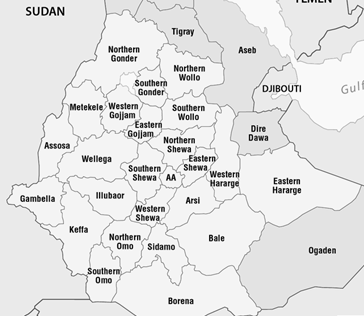History of Ethiopia. Kingdom of Aksum
Ethiopian History: the oldest independent African state

History of Ethiopia (East Africa) is the oldest independent African state and one of the oldest in the world
- Only two African states have not been colonized: Ethiopia (except the Italian occupation, 1936-1941) and Liberia
- Perhaps for this reason, the headquarters of the African Union and the Economic Commission for Africa (ECA) are in Addis Ababa
Surely the appearance of the modern homo sapiens took place in the Ethiopian territory.
Kingdom of Aksum (400 BC)
- 400 BC: arrive populations from Arabia
- Expansion of the Kingdom of Aksum
- The Kingdom of Aksum comprised a large part of northern Ethiopia, some border regions of Sudan, most of Eritrea and a part of the west coast of the Arabian Peninsula.
- Trade with India, Persia and Rome
- Introduction of Christianity
- Creation of the Ethiopian Church (Monophysite)
- Scripture ge'ez for the liturgy
- Expansion of Islam
- Isolation of the Kingdom of Aksum
- 8th century: decline of the Kingdom of Aksum
- Obelisks of Aksum
Zagüe dynasty
- 1000: Princess Guedit (or Judith) non-Christian, defeat the last of the kings of Axou
- Persecution of Christians
- 1137: Mara Takla Haymanot (Agaw) defeats the descendants of Princess Guedit
- Foundation of the Zagüe dynasty
- Capital: Roha (Lalibela)
- 1185-1225: the Gebra King Maskal Lalibela
- Rock Churches of Lalibela
- 1270: collapse of the Zagüe dynasty
Restoration of the Solomonic dynasty
- Yekuno Amlak defeats the last King Zagüe
- Foundation of the Solomonic dynasty, proclaimed heiress of Ménélik I, sons of Solomon and the Queen of Sheba
- 1300: Book of glory of the kings of Ethiopia (Kebra Nagast)
- Negus Negusti, King of kings or Ethiopian Emperor (Amhara)
- Objective: to achieve the Ethiopian national unity founded on Christian religion
- Provinces: Tigray, Amhara and Shoá
- 13th century: founding of Mek'ele
Contacts with Portugal
- 1490: an embassy of the King of Portugal arrives (Covilha)
- The Ethiopian Emperor asks for help to Portugal to fight against Muslims
- 1520: Portuguese fleet (Red Sea)
- 1528-1540: Muslim invasion (Ahmad ibn Ibrahim al-Ghazi)
- 1543: Expulsion of Muslims (battle of Wayna Daga)
- Arrival of the Portuguese Jesuit missionaries (Pedro Páez)
- Conversion to Catholicism of numerous Ethiopians
- The Negus Susneyos proclaims the freedom of choice between Catholicism and Coptic faith
- 1633: expulsion of the Jesuits (Fasiladas the Great)
- Persecution of Catholicism
Gondar Period (1630-1769)
- The Emperor Fasiladas the Great (1632-1667) settled in Gondar
- Fasiladas Castles
- International isolation of Ethiopia (expulsion of the Jesuits)
- Iyasu I the Great (1682-1706) ends the isolationist policy (French ambassador)
- Consolidation of the authority of the Negus over the Coptic Church.
- 1755: Death of King Iyasu II
- 1769-1855: Era of the Princes (Zemene Mesafent)
- Decay of the Solomonic dynasty
- Conflicts between Muslims and Christians
- 1885: King Lij Kassa. End of the era of the Princes
Ethiopian Empire (1855-1974)
Menelik II
- Menelik II modernises the Ethiopian Kingdom
- Addis Ababa Foundation
- Abolition of Slavery
- Compulsory education
- Control of the Ethiopian ports (Massawa, Zeila, Obók) by Europeans
- 1889: treaty of Uchalli with the Italians
- 1896: Battle of Adoua with the Italians
- Italy signs the Treaty of Addis Ababa, recognizing Abyssinia as an independent State
- 1902: foundation of Dire Dawa
- 1913: death of Menelik II
- Iyasu V (converted to Islam)
- 1916: dismissal of Iyasu V
- Queen Zauditu (daughter of Menelik): regent and heir of Ras Tafari
- 1930: death of Zauditu
Haile Selassie I
- 1930: Ras Tafari Makonnen (Haile Selassie) Emperor
- 1931: Constitution (the Emperor receives all the power of divine right)
- Trade agreements with Japan and the United States
- 1935-1941: Italian occupation
- Addis Ababa, conquered by the Italians on May 5, 1936.
- Italy officially annexes Ethiopia on May 9, 1936, creating the Italian Empire in the form of a colonial satellite state called Italian East Africa
- Exile in England
- 1941 (Second World War), the Italians are defeated by the British, expelled from Ethiopia, Eritrea and Somalia.
- Haile Selassie regains the throne, annexing the territory of Eritrea.
- Rastafari Movement (Haile Selassie as the Black Messiah)
- 1930: expansion of the Rastafari movement to Jamaica
- Bob Marley
- 1970: worldwide expansion of the Rastafari movement
Ethiopian civil war (1974-1991)
- 1974: overthrow of Haile Selassie
- Democratic People's Republic of Ethiopia
- 1991: fall of the communist regime of Mengistu in 1991
- End of the Ethiopian civil war
 Ethiopian Students from Ethiopia
Ethiopian Students from Ethiopia

More information: International Trade and Business in Ethiopia, at EENI Global Business School.



 Tweet
Tweet

